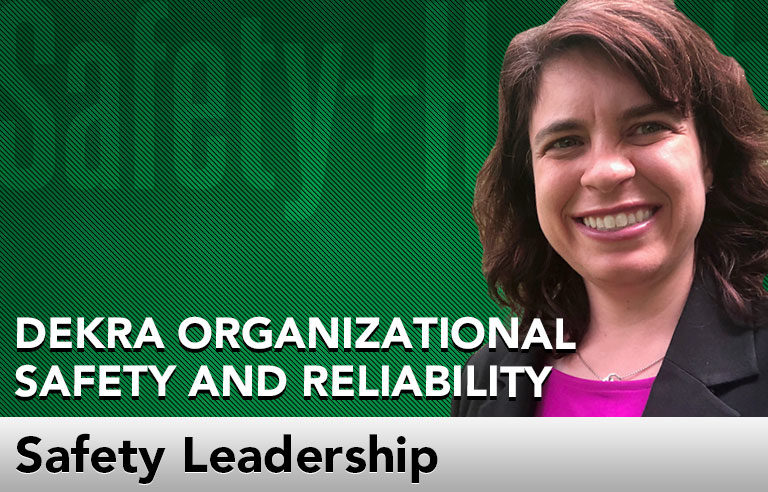Safety Leadership: Commit to a culture of learning

Editor’s Note: Achieving and sustaining an injury-free workplace demands strong leadership. In this monthly column, experts from global consulting firm DEKRA share their point of view on what leaders need to know to guide their organizations to safety excellence.
In safety, learning organizations don’t need to experience a catastrophe to understand how to prevent one from happening. They all recognize that tolerating activities that may lead to a fatal injury, harm to a firefighter or the need for a community to shelter-in-place are unacceptable. The goal of high-reliability safety is to focus on early warning signals that are often overlooked. In this process, safety leaders can improve how they identify and shape a response to those signals.
Key to this process is creating a culture of learning. Learning plays an important role in organizational performance when it comes to establishing a safe operation. In fact, we define a learning organization as one that continuously challenges, develops and – yes – learns how to achieve long-lasting and high safety performance.
Lead with vulnerability
Learning becomes part of the fabric of an organization through vulnerability. I often tell my clients that leading with vulnerability is like rolling over a speed bump in a car – it forces us to slow down and become more aware of our environment and actions. Just as speed bumps help prevent speeding cars from causing chaos on busy streets, creating an organizational sense of unease helps organizations reduce and avoid catastrophic events.
Leaders who want to lead with vulnerability are those who ensure each person in the organization is self-aware of their actions and environment. Leaders understand that the organization is vulnerable and can fail. They also actively promote to the workforce that everyone is needed to prevent a catastrophe. This is an all-hands-on-deck approach because it affects every hand on deck.
Show that learning is a priority
What moves an organization to embrace a vulnerable mindset is a leader who is vulnerable to learning. What we’ve seen through our work is that leaders who lead through vulnerability usually have six important attributes, all of which strengthen learning.
They make inquiries. Leaders are in a relentless pursuit of information and, in the process, are in a proactive position to discover system deficiencies.
They innovate. These are leaders who are willing to think “out of the box” within a change management process. They’re open to different ways of doing things.
They engage. Too often, leaders stay holed up in their office and consider safety as something to be dealt with by frontline supervisors. Vulnerable leaders create change in ways that increase productivity and commitment across all levels.
They act. Once they discover system deficiencies, vulnerable leaders are responsive. They don’t let information sit. They’re invested in driving change to enforce a safer organization.
They adapt. Vulnerable leaders are agile, resilient and quick to respond to unexpected events. Strong safety leaders are ready to act and switch gears, if necessary, to save lives.
They reinforce. Vulnerable leaders align behaviors, culture and systems so they all support a common purpose.
It shouldn’t take a catastrophic incident for leadership to make these changes. In fact, leaders can be more intentional simply by invoking five key phrases: “How can that happen here?” “Show me,” “I want to talk to an expert,” “We need to step up” and “Who did we miss?”
These phrases open conversations. By using them, leaders can show that learning is a priority in identifying and responding to signals that hazardous risks are at play.
Make it a reality
An organization can be on the path to high reliability if its leaders are committed to creating a learning culture. They do this through their actions, how they engage workers, how they adapt to change and how they support the attributes of a learning organization in their company. Learning organizations must involve everyone, from the frontline workers to those in the C-suite.
All of these ways will help make high reliability a reality for the things a good leader should care about: our workers, our first responders and our community.
This article represents the views of the authors and should not be construed as a National Safety Council endorsement.
 Sarah Eck is the senior process safety development engineer for DEKRA North America (dekra.us) with experience in building and improving safety programs to reduce catastrophic risk. She is a professional engineer and certified process safety professional.
Sarah Eck is the senior process safety development engineer for DEKRA North America (dekra.us) with experience in building and improving safety programs to reduce catastrophic risk. She is a professional engineer and certified process safety professional.
Direct to your inbox: Sign up to be notified in email about new "Safety Leadership" columns.
Post a comment to this article
Safety+Health welcomes comments that promote respectful dialogue. Please stay on topic. Comments that contain personal attacks, profanity or abusive language – or those aggressively promoting products or services – will be removed. We reserve the right to determine which comments violate our comment policy. (Anonymous comments are welcome; merely skip the “name” field in the comment box. An email address is required but will not be included with your comment.)

